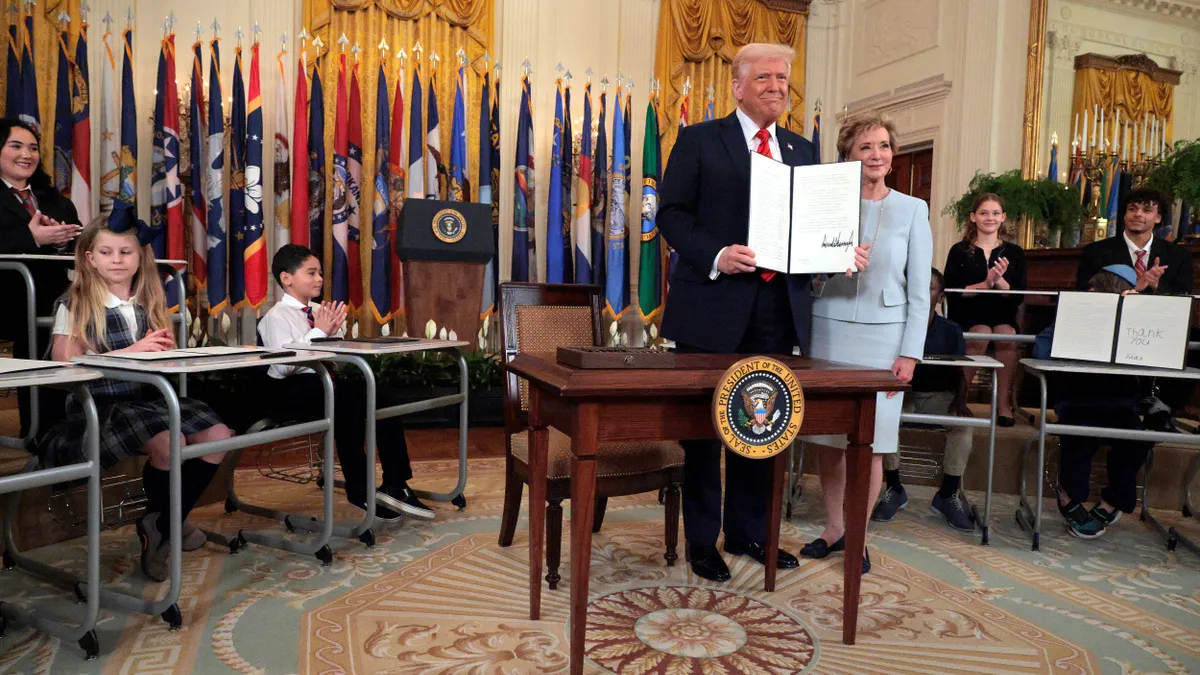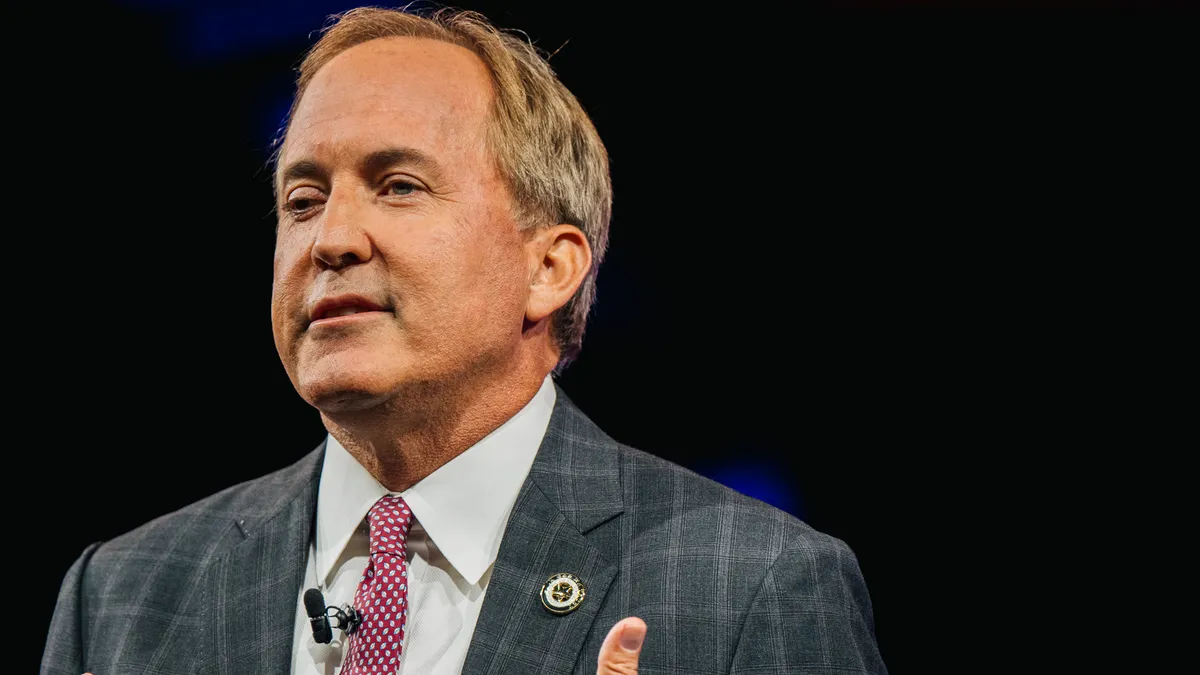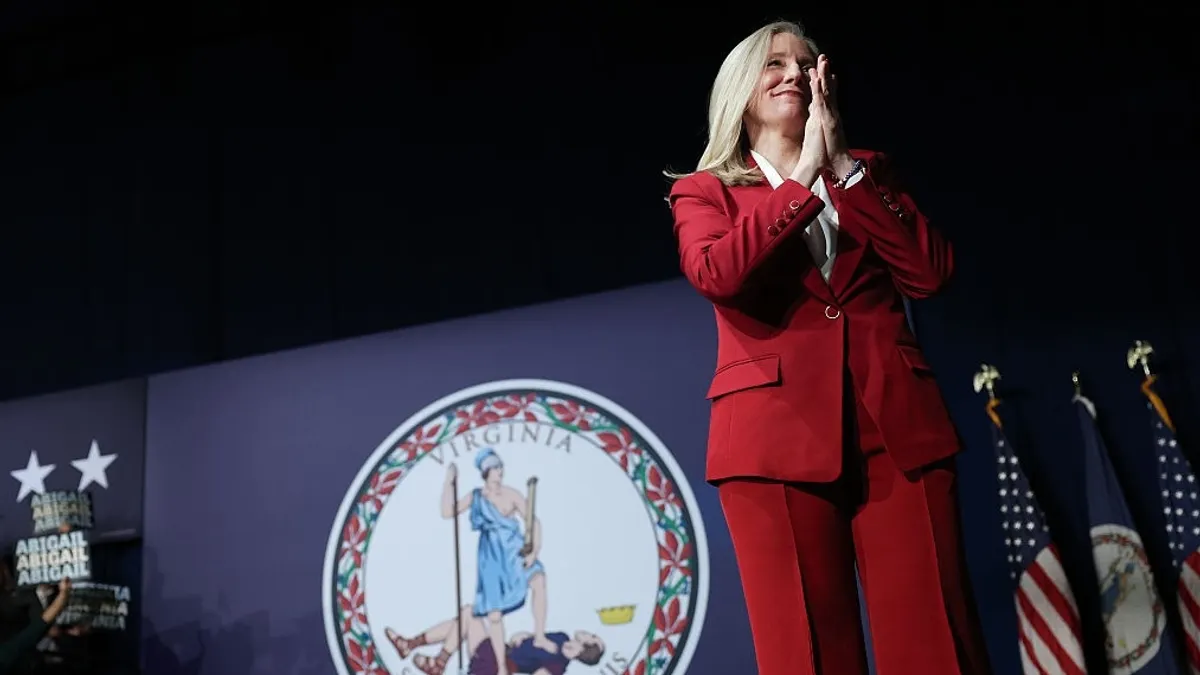The U.S. Department of Education is transferring management of six programs to other federal agencies in the Trump administration's continued push to eventually close the agency and give states more control over education funding decisions, according to a Tuesday announcement.
The shifting of responsibilities is a historic change for the 46-year-old agency that has been the central hub of federal grant-making, technical assistance and civil rights enforcement for schools and colleges.
The programs to transfer include:
- The Office of Elementary and Secondary Education to the U.S. Department of Labor.
- The Office of Postsecondary Education's institution-based grants to the Labor Department.
- Indian education programs to the U.S. Department of Interior.
- On-campus child care support for parents enrolled in college to the U.S. Department of Health and Human Services.
- Foreign medical accreditation to HHS.
- International education and foreign language studies programs to the U.S. Department of State.
The changes do not include movement for the management of special education, civil rights enforcement or student financial aid. However, a senior Education Department official who spoke during a Tuesday press call said the agency was continuing to explore options for those programs.
The transfers announced Tuesday would add to an interagency agreement that's already in place with the U.S. Department of Labor, which is handling day-to-day management of career and technical education under the agreement made in May.
The Trump administration has said repeatedly that it wants to reduce federal interference and red tape surrounding education, and that it wants to give states more autonomy over how they spend federal taxpayer funds.
In a statement announcing American Education Week on Monday, President Donald Trump said, "By dismantling the Department of Education, my Administration has returned control of education to where it belongs — with States, local communities, and parents who are best equipped to meet the needs of their students."
And in an opinion piece published in USA Today on Sunday, U.S. Education Secretary Linda McMahon said the recently ended 43-day shutdown of the federal government showed that the Education Department isn't needed.
"The shutdown proved an argument that conservatives have been making for 45 years: The U.S. Department of Education is mostly a pass-through for funds that are best managed by the states," McMahon wrote.
The senior Education Department official speaking during the press call said the agency is "confident that in streamlining that bureaucracy at the end of the day, it means more dollars to the classroom, to the grantees, that does not get siphoned off through bureaucracy. And so we think that this really does give states more power to really determine how those dollars are spent and to best, best manage them."
Trump and McMahon have been steadfast about downsizing the federal agency on the way to eventually closing it.
In March, Trump signed an executive order calling on McMahon to facilitate the agency's closure to "the maximum extent appropriate and permitted by law." In a speech before the signing ceremony, Trump said other agencies can absorb the Education Department's core functions, such as the management of Pell Grants, Title I funding and resources for students with disabilities.
Closing the Education Department altogether requires approval from Congress. However, over the past 10 months since Trump has been president, the agency's workforce has shrunk by half, from 4,133 on Jan. 20 when Trump was inaugurated to 2,536 on Nov. 12, according to a recent court document.
The staffing reductions came from layoffs, buyouts and attrition. For instance, the Office for Civil Rights saw 137 layoff notices on Oct. 10 among its 446-person staff. In the Office of Special Education and Rehabilitative Services, 121 of 135 employees got reduction-in-force notices that day.
The Education Department reinstated the laid-off employees last week as part of the congressional deal to end the budget impasse and reopen the government. The continuing resolution signed into law on Nov. 12 also prohibits the Education Department from issuing any more RIFs through Jan. 30.
What's changing?
Under the agreements announced Tuesday, the Education Department would still be the agency responsible for these programs, but much of the day-to-day operations would transfer to the other agencies. These interagency agreements seem to acknowledge federal laws that require certain education operations to remain within the Education Department.
Some of the management being transferred includes the distribution of federal grants, such as $28 billion for elementary and secondary education operations, according to the senior department official. For postsecondary education operations, the management of about $3.1 billion will transition to the Labor Department.
As to why elementary and secondary and postsecondary program management would be housed at the Labor Department, fact sheets from the Education Department contended the structure allows for better transitions between educational stages and as older students prepare for the workforce.
Education Department staff working on the programs now under an interagency agreement will transfer to new agencies. State leaders and others "can really be confident that these programs will continue to have the expertise and concierge level service that states have come to expect," the official said.
The senior department official said details on the number of employees transitioning is forthcoming. There is a lag between the interagency agreement signings and when they are fully executed. More details will be finalized over the next few weeks and months, the person said.
Some critics have raised doubts that moving education programming across multiple agencies will streamline services. When the Education Department moved CTE management to the Labor Department this year, organizations like AASA, The School Superintendents Association, and the Association for Career and Technical Education voiced concerns about the lack of stakeholder engagement and the potential for confusion and inefficiencies.
David Schuler, executive director of AASA, said in a statement that the interagency agreements announced Tuesday raises questions about how the moves will affect school districts and the consistency of federal support for students.
Specifically, Schuler questioned how the shifting of Title I funding and the Rural Education Achievement Program out of the Education Department would streamline operations for the nation’s small, rural and low-capacity districts. Another unknown is if states have the financial and personnel capacity to take on expanded responsibilities currently handled by the federal Education Department, he said.
"A centralized federal agency plays a vital role in providing continuity across all states. It helps ensure that every child, in every community, benefits from fair access to federal programs and protections," Schuler said.
Special education advocates have already started campaigns against moving management of programs under the Office of Special Education and Rehabilitative Services to another agency. They say that if HHS takes over management of special education, the move sends a message that, at the federal level, students with disabilities primarily would be viewed for their medical conditions, not for their academic potential. Advocates also worry about losing access to the Education Department staff who have expertise in special education.
Denise Forte, CEO of EdTrust, a nonprofit focused on educational equity, said in a statement Tuesday that moving the Office of Elementary and Secondary Education's Title I management serving low-income schools and districts to the Labor Department "makes no sense."
The move would "erode oversight of required annual assessments and school accountability, as well as grants that fund a host of important programs, from charter and magnet schools to assistance for students experiencing homelessness," Forte said in a statement.
The Council of Chief State School Officers, in a Tuesday statement, said its primary goal is for the Education Department to "continue to meet its statutory obligations to states and local districts in a timely manner."
The statement said it encourages the Education Department to meet with state education leaders to ensure seamless transitions and that funding flows without interruption to support students.
Meanwhile, Education and Workforce Committee Chairman Tim Walberg, R-Mich., said in a Tuesday statement that the interagency agreements are a move toward "right-sizing" the Education Department.
"The past few decades have made one thing clear: the status quo is broken," Walberg said. "As the bureaucracy swelled, left-wing bureaucrats were emboldened to waste taxpayer dollars on a radical agenda. As a result, our students have been left in the dust. Test scores are plummeting, students can’t read, and college graduates leave school burdened by debt rather than equipped with workforce-ready skills."






















